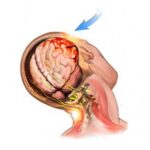Our law firm concentrates in personal injury claims arising from car accidents and other vehicular collisions. A large majority of the cases we handle involve injuries to the head & neck. As a result of our experience in dealing with insurance representatives and defense attorneys in hundreds of neck injury cases, the following provides insight into the important issues that concern “medical causation”.
When I first meet with a client that has suffered a neck injury in a vehicular collision, in many cases my client does not show any demonstrable sign of neck injury. Our client usually has been to the hospital emergency room where a set of cervical spine x-rays have been taken. The x-rays are read by a hospital radiologist who states the x-rays are “normal” and the injured client is released from the hospital with medication prescriptions and a suggestion to go to their personal physician if the pain gets worse.
When this circumstance arises in our office, I immediately consider retaining an independent radiologist to read the client’s cervical x-ray films. The reason I do this is because I know the hospital radiologist probably read the x-rays as “normal” because he or she did not see any apparent fractures. In fact, when our expert radiologist reads the exact same hospital x-ray films there is a good probability that they will find vertebral misalignment and/or a reversal of the normal cervical curve. If evident on the x-ray films, these kinds of abnormalities (vertebral misalignment, loss of cervical curve, etc.) can be vital in showing the collision was the direct cause of the traumatic injuries.
I take great care in selecting the independent radiologist who will read my client’s films. Preferably, I want a radiologist with a chiropractic background. This is because chiropractors are very concerned with the vertebral positioning and the objective of their treatment is to restore proper positioning in order that the injured patient’s cervical spine can be restored to normal function. I also want an independent radiologist who will have the added benefit of teaching the jury that vertebral abnormalities create pressure on the nerve roots that exit the spinal column in the cervical region. In my experience, a medical doctor, a physical therapist, or a chiropractor can never take the place of a qualified radiologist in proving medical causation related to a neck injury.
The other item I would mention is that a expert radiologist can help dismiss issues concerning my client’s credibility. Many neck injury cases happen due to rear end accidents where the damage to the vehicles appear to be minor. Insurance claim adjusters and defense attorneys frequently rely upon the damage of the vehicles to support their position that the impact was minor and the client could not have been injured.
Recently, I represented a client who suffered a car accident neck injury case in Clay County, Missouri. The insurance adjuster indicated to me that they were prepared to try the case to a verdict citing that my client was over-dramatizing their neck injuries, stating to me that “a picture is worth a thousand words”. Of course, they were referring to the picture of my client’s car which showed several small dents from the impact. Because we had already secured the important x-ray evidence from the radiologist, the x-ray pictures in this neck injury case proved to be worth more than a thousand words, and much more compensation for this deserving client.





